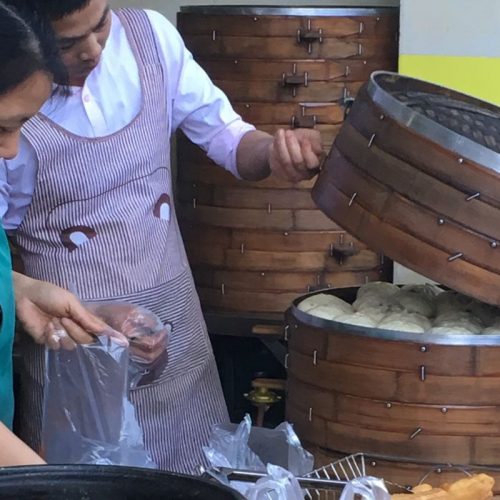Baozi are Chinese ‘convenience’ food and is hearty, nutritious and filling. Part of a typical fast Chinese breakfast. It comes with meat or only with vegetables and tofu.
Origin of baozi
Prior to the Northern Song dynasty (960-1279), the word mantou (steamed bun) was used for both filled and unfilled buns. Written records from the Song dynasty report baozi as filled buns. And legend says the baozi were invented by military strategist Zhuge Liang. If so, the nutritious food is still easy to take away and to consume and is harnessing many Chinese for the day. Later the word mantou started to mean in Mandarin only unfilled steamed buns. Its norther heritage is seen from the fact that the dough is a wheat dough. Wheat only grows in Northern China. While baozi are now consumed all over China, Southern similar delicacies would be made of rice flour.
Chinese baozi variations
In the morning in many Chinese neighborhoods, you see the steaming bamboo or now stainless steel steaming pans in the streets where many commuters stop on their (e-) bike or step. This Chinese ‘convenience’ food is hearty, nutritious and filling.
Pork/vegetable combination fillings are most common in baozi, but many variations are possible. Such as chicken, lamb and vegetarian being the most occurring other options.
Lambs meat has made it into baozi along the old silk route. Also sold along with the baozi are warm ‘tea’eggs, hard boiled eggs marinated in a mixture of tea, herbs (e.g. star anise) and soy sauce, giving them a nice and lightly salted flavor and the egg-white a brownish appearance. A good fast breakfast is obtained for several renmimbi, 30 or 40 U.S. dollar cents, perhaps a bit more in the big cities in the east of China.
Special equipment
- steamer
- dough pin

Baozi (Chinese steamed filled buns)
Ingredients
Ingredients for the dough
- 5.64 oz (160 g) white, all purpose flour (protein content 10%)
- 3.88 oz (110 g) water 25 C
- 0.07 oz (2 g) dry baker's yeast
- 0.035 oz (1 g) baking powder
- 0.052 oz (1.5 g) salt
Ingredients for the filling
- 7.05 oz (200 g) chicken (or lamb or beef or ....)
- 1 egg
- 1/4 cup cut white cabbage
- 1/4 cup minced spring onion
- 1/8 cup freshly minced ginger
- 2 tbsp light soy sauce
- 1 tbsp rice wine (Shaoxingjiu)
- 1 tbsp vegetable, cooking oil rapeseed or sunflower
- 1 pinch of salt
- 1/4 tsp spicy jam (optional)
Instructions
Instruction to make the dough
- Mix all ingredients
- dust your hands with some flour and knead the mixture
- Let ferment at a warm place (25-30 C) for 1.5 h
- Thereafter, stretch and knead the dough again and let rest for 30 min
- Then divide the dough in pieces and roll each piece in a flat round shape with the dough pin
Instructions to make the final baozi
- Mix all the ingredients and check the taste. For a vegetarian version, leave out the meat. Consider to use mushrooms instead
- Take the individually rolled dough pieces and fold-in the ingredients. Ensure the dough is stretched and 'pressed' together at the bottom of each baozi
- Let the baozi ferment at 25 -30 C for around 30-45 min on a perforated plate and covered to prevent them form drying out
- Place the perforated plate with the baozi in the steamer and steam for 20 min. Thereafter switch off the fire but keep them covered, until they can be served.

Notes
Remarks
- Practice makes perfect.
- One of the few foods that you may eat with your fingers, but using chopsticks is more civilized.



